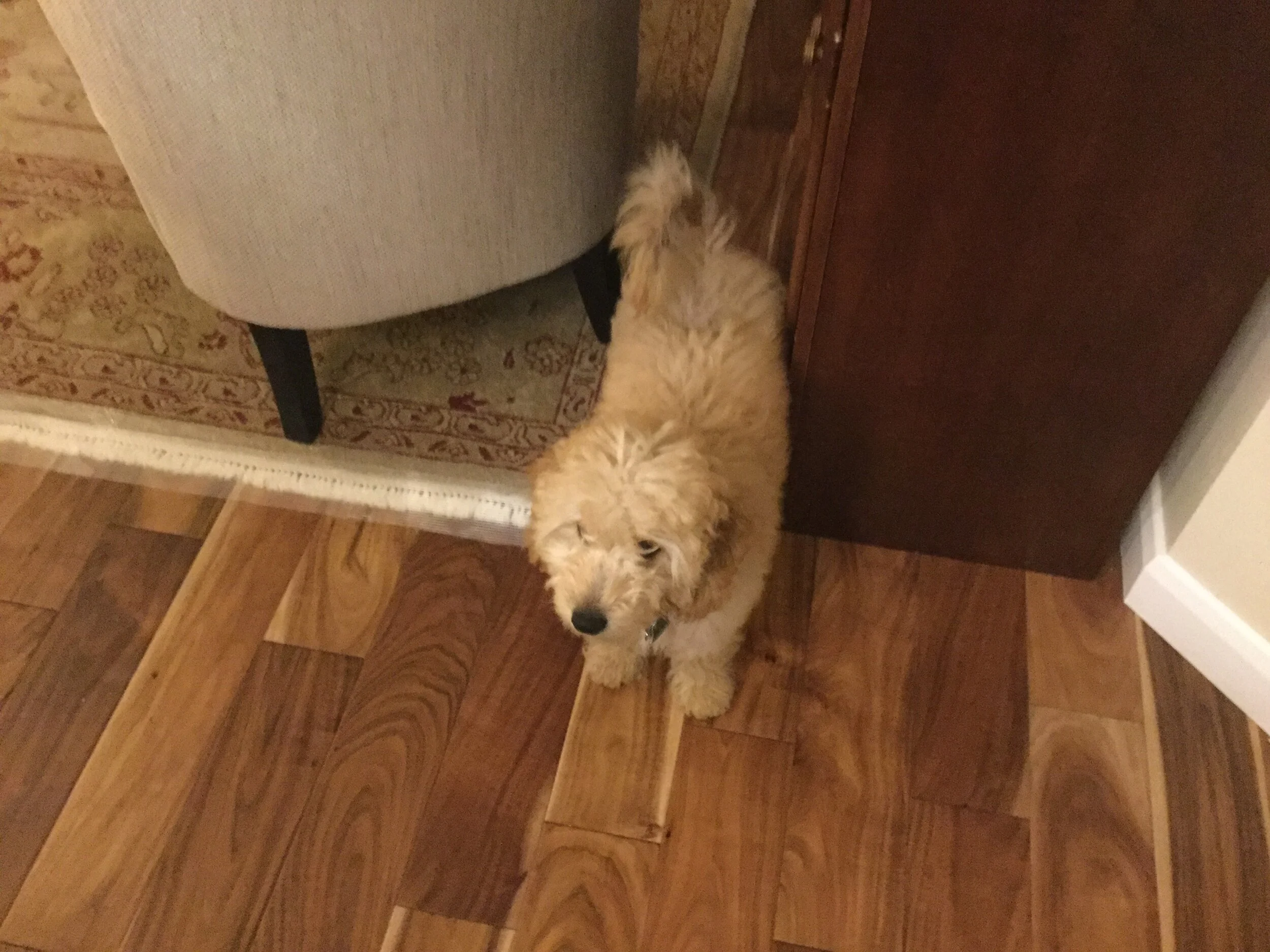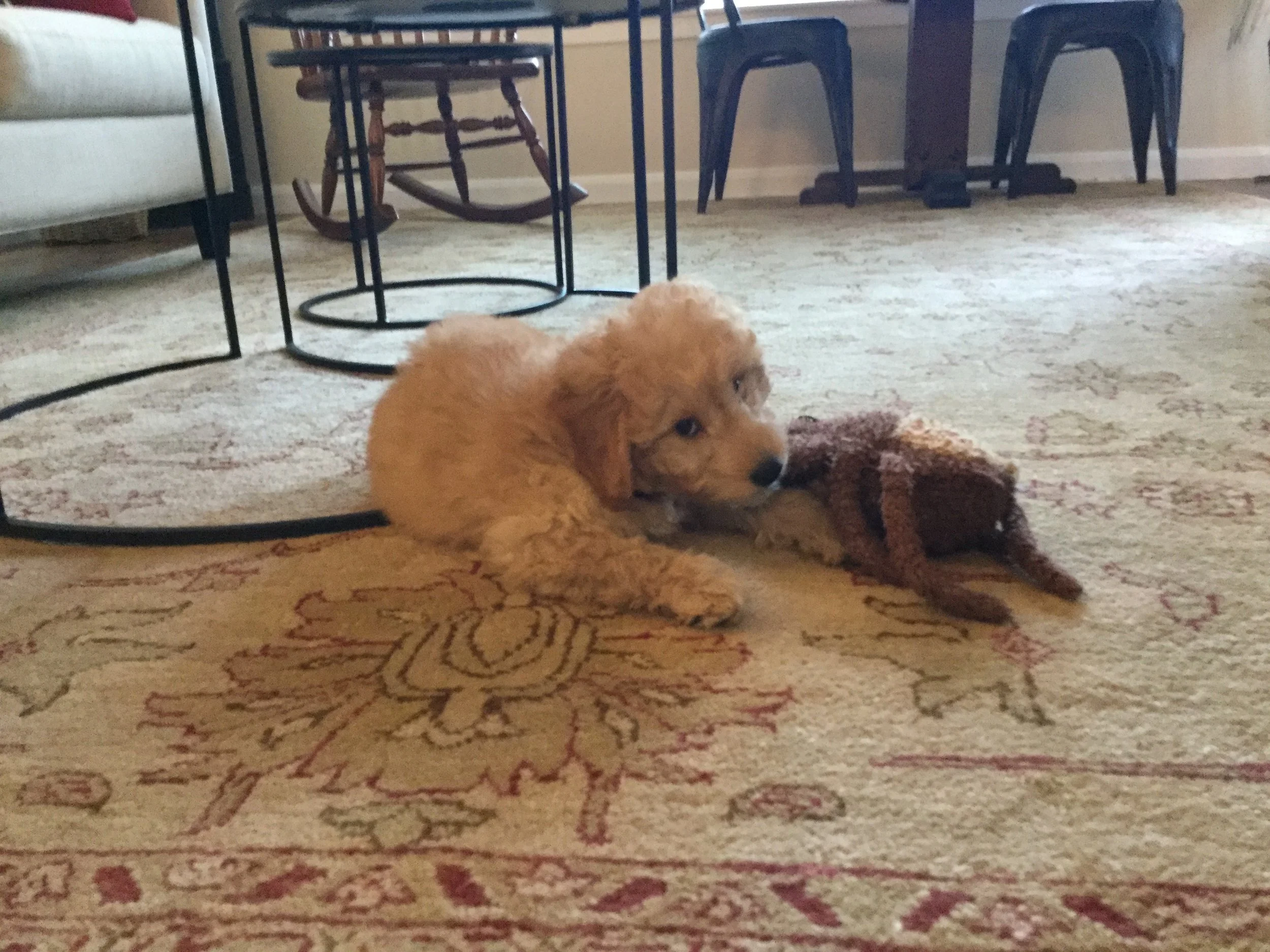#7 PUPPY - SCOOTER SUBLIME'S TAIL
SCOOTER’S TAIL
Coffee, computer, and a quiet house this pre-dawn Christmas morning . It’s Scooter Sublime time in my mind. I’m tapping thoughts of his tail from the tips of my fingers. I’ve been wondering, is it possible that his tail could be broken? You know, benevolently. That is, straightened at the tip; the tip that tucks in a tight curl over his back like the best of India’s street dogs, but his tail sweeps his spine with every wag (and those wags rarely rest) managing, in this his fourth month of life, to comb a near bald spot where soft puppy coat should stand.
“Wait,” I say when brushing him. This is a designer dog. This is a fully-fledged, papered, AKC registered, mostly poodle golden-doodle. The tail of this feisty fidgeter should resemble that of every poodle I’ve owned or observed. You know, dogs of relatively short, and certainly straight, tails; tails pointed skyward.
I’m remembering a recent blog I wrote, mentioning the slightly sordid family tree of Jesus, and I wondered, whether, way back in my puppy’s family tree, some universally curling-tailed street dog snuck his signature into Scooter’s genealogy, and those genes woke up to proudly offer our pup his tail.
So, I googled (new verb) “pictures of poodle’s tails,” and I was taken to task. Poodles, left to nature’s plan, have lovely curled tails that not infrequently sweep over their spines, as Scooter’s tail does. However, people who own poodles prefer style, and style demands that poodle tails be docked. Docking makes tails straighter. And well, you know, the snobbish American Breed Standard says poodle tails “should never be curled or carried over the back.” So what, that like people, dog amputations can cause phantom pain. So what, that poodles naturally have curly tails, and that great purpose lies in the use of the tail—all the way to the tip of it.
Without worrying about the unattractively swept spot on Scooter’s furry back, how would I have known that removing even a tail’s tip would “reduce ear movement” and even reduces tail wagging, which, hello, is a big part of any dog’s communication. Long tails stabilize, tails are swimming rudders, tails are tucked as a sign of submission (which for goodness sake may save a dog damage) or unwillingness to share genital information—docked tails don’t tuck well. Tails fly high when confidence is. If a threat seems imminent, wags get held high, become swift, and of a narrow scope. What brutes we dockers are!
I’ll not start on dew claws, those useable dog thumbs. Apparently, poodles (and so probably golden-doodles) do use them but people don’t like them. Snip!
What greater Christmas gift can I give Scooter Sublime than my education about his tail, the section of his spine deliberately aired and admired. It won’t be docked. It won’t be tipped. I will praise his use of that natural appendage that at its surface, all-the-way-to-the-tip, holds scent glands (fats and oils, waxes, phospholipids [look it up] and steroids), all of which aid in his identification. Personally, I use sight, tags, and his name, but other animals assess the smells of his tail.
“Oh, it’s you!” say Scooter’s growing group of canine friends.
When Scooter was about three weeks old, he began learning tail-talk from his mom. “Shake it,” she said, demonstrating, and shake it he did, toppling with the attempts, but mastering the skill by the time we picked him up a few weeks later. Daily, his vocabulary grows.
So goes the tale of tails. Tails wag in excitement. A lowered tail helps in a climb. For example, Scooter straightens and lowers his long tail, calculates, then leaps at the edge of our sleeping houseguest’s bed. It’s a stabilizer, that tail, and thanks to built-in help, before long, he will master the climb.
Long tails wag in excitement (“Oh look! It’s a person coming down the corridor! Wag! Wide, wide Wag!) Slow wags are tentative (What’s that?” Scooter asks of a cardboard box on the sidewalk. “I haven’t seen that before.”) If what I read is right, dogs don’t wag tails when alone (I don’t know if there is a sound in the forest when a tree falls without someone around to hear it).
Scooter Sublime’s tail is, as most retriever’s tails are—long, and as most poodle tails are, his is curled, and tipped over his back, placing a permanent part in his soft puppy coat. And thank goodness for it.
I use Scooter’s tail, the exterior extension of his spine, to catch the pup when he darts under the sofa, a chair, a bed, or table with some unapproved item clenched in his jaw, clutched between sharp baby teeth. That tail is a natural tool for him but it’s also a tool for me. It’s a win-win, this pup’s tail. I might begin with, “Scooter, Sit! Stay1” Scooter says, “Scurrying now!” He runs. I reach for the tail. Look, training is a long process. The tail is an immediate solution. Win-win.






